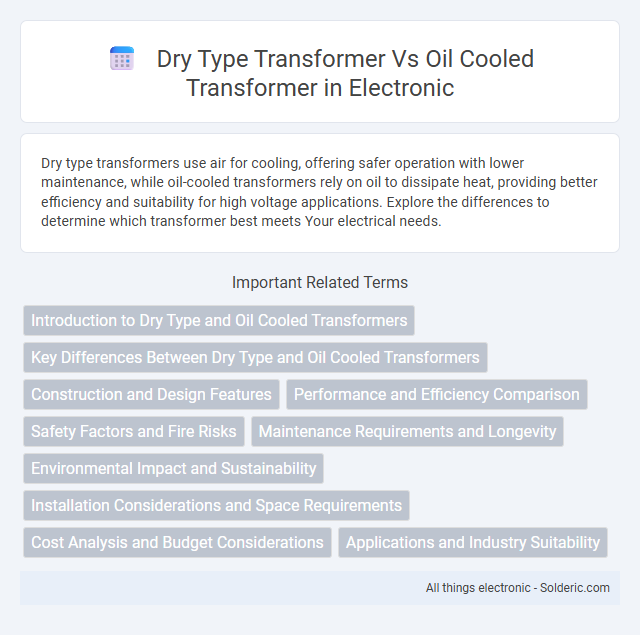Dry type transformers use air for cooling, offering safer operation with lower maintenance, while oil-cooled transformers rely on oil to dissipate heat, providing better efficiency and suitability for high voltage applications. Explore the differences to determine which transformer best meets Your electrical needs.
Comparison Table
| Feature | Dry Type Transformer | Oil Cooled Transformer |
|---|---|---|
| Cooling Medium | Air | Mineral or synthetic oil |
| Fire Risk | Low | Higher due to flammable oil |
| Maintenance | Low, simpler | Higher, regular oil checks required |
| Environmental Impact | Eco-friendly, no oil leaks | Risk of oil spills and contamination |
| Installation Location | Indoor and outdoor (limited outdoors) | Allows outdoor with proper containment |
| Cost | Higher initial cost | Lower initial cost |
| Efficiency | Generally lower efficiency at high loads | Better efficiency with effective cooling |
| Size and Weight | Bulkier and lighter | Compact and heavier |
Introduction to Dry Type and Oil Cooled Transformers
Dry type transformers utilize air for cooling and are typically used in indoor or environmentally sensitive locations due to their reduced fire risk. Oil cooled transformers, filled with insulating oil, provide efficient heat dissipation and are commonly employed in outdoor and high-capacity electrical substations. Both types serve critical roles in power distribution, with dry type transformers favored for safety and maintenance ease, while oil cooled transformers excel in thermal management and durability.
Key Differences Between Dry Type and Oil Cooled Transformers
Dry type transformers use air for cooling and are encapsulated with epoxy resin, making them safer for indoor use and environmentally friendly by eliminating oil leak risks. Oil cooled transformers rely on mineral or synthetic oil for heat dissipation, providing superior cooling efficiency and higher power capacity, ideal for outdoor or industrial settings. The choice depends on factors like maintenance requirements, fire hazards, installation location, and load demands, with dry types favored for low-fire risk applications and oil cooled models preferred for heavy-duty performance.
Construction and Design Features
Dry type transformers feature air-cooled windings encapsulated in epoxy resin or cast coils, eliminating the need for liquid insulation and reducing fire hazards. Oil-cooled transformers utilize mineral or synthetic oil for insulation and cooling, with a sealed or conservator tank housing the oil surrounding the windings and core. The robust oil-filled design provides superior heat dissipation and higher capacity for outdoor or heavy-duty applications compared to the compact, maintenance-friendly dry type transformers typically used indoors.
Performance and Efficiency Comparison
Dry type transformers offer superior safety with lower fire hazards and reduced maintenance, making them ideal for indoor and environmentally sensitive locations, but they generally have higher heat dissipation and lower efficiency compared to oil-cooled transformers. Oil-cooled transformers provide better cooling performance through natural or forced oil circulation, resulting in higher load capacity and improved thermal efficiency, often reaching efficiency levels above 98%. While oil-cooled transformers excel in heavy-duty industrial applications due to their robust cooling systems, dry type transformers are preferred for moderate loads where minimizing environmental and fire risks is critical.
Safety Factors and Fire Risks
Dry type transformers offer enhanced safety due to the absence of flammable insulating oil, significantly reducing fire hazards in indoor and densely populated environments. Oil-cooled transformers, while efficient in heat dissipation, pose higher fire risks because of oil leakage and ignition potential under overheating or mechanical failure conditions. Safety factors favor dry type transformers in facilities where fire prevention and minimal maintenance are critical considerations.
Maintenance Requirements and Longevity
Dry type transformers require less frequent maintenance due to their sealed and ventilated design, which reduces the risk of contamination and corrosion compared to oil cooled transformers. Oil cooled transformers need regular oil testing, replacement, and leak checks to ensure insulation integrity and cooling efficiency, which increases maintenance costs and downtime. Longevity of dry type transformers is generally enhanced in harsh or indoor environments, while oil cooled transformers often have a longer operational lifespan under optimal outdoor or heavy load conditions due to superior cooling capacity.
Environmental Impact and Sustainability
Dry type transformers offer significant environmental advantages over oil-cooled transformers by eliminating the risk of oil leaks and contamination, reducing soil and water pollution hazards. These transformers use air for cooling, which enhances sustainability through lower fire risks and easier recycling options, aligning with eco-friendly energy initiatives. Choosing dry type transformers supports Your commitment to minimizing environmental footprint and promoting long-term sustainability in electrical infrastructure.
Installation Considerations and Space Requirements
Dry type transformers require less installation space as they do not need oil containment systems or fire protection measures, making them suitable for indoor or confined environments. Oil cooled transformers demand larger areas due to their oil tanks, cooling radiators, and spill containment infrastructure, necessitating compliance with safety regulations and environmental controls. The compact footprint of dry type transformers enables easier integration in urban or building installations where space is limited.
Cost Analysis and Budget Considerations
Dry type transformers generally have higher initial costs compared to oil-cooled transformers due to their advanced insulation materials and maintenance-free design requirements. However, oil-cooled transformers may incur additional expenses over time for oil handling, potential leak management, and fire safety systems. Your budget should consider not only upfront costs but also long-term operational and maintenance expenses to determine the most cost-effective option for your application.
Applications and Industry Suitability
Dry type transformers are ideal for indoor applications in commercial buildings, hospitals, and schools due to their enhanced safety and minimal maintenance requirements. Oil cooled transformers suit outdoor and heavy industrial environments like power plants and manufacturing facilities, where efficient heat dissipation and high load capacities are essential. Industries demanding explosion-proof or environmentally friendly solutions prefer dry type transformers, while sectors prioritizing high power ratings and robustness often select oil cooled options.
dry type transformer vs oil cooled transformer Infographic

 solderic.com
solderic.com